Christopher Llewellyn Reed’s Take on 2019 Tribeca, Part 1: VR, AR and Immersive Cinema
Written by: Christopher Llewellyn Reed | May 8th, 2019
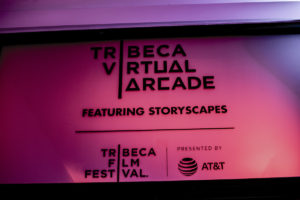
For the second year in a row, I attended the Tribeca Film Festival, this time for its 18th iteration, running April 24-May 5. As I did in 2018, I begin my coverage with a review of the virtual reality (VR) movies I saw, adding into the mix one example of augmented reality (AR), one immersive/interactive documentary, several experiences that applied immersive techniques to their VR experiences, and a few Cinema360 movies. Some involved haptic controllers and attendant interaction, while others just asked you to watch, swiveling within one’s chair as much as desired. I wish I could have caught more, though I spent significantly more time in the VR hub than I did last year. I recommend to any future attendee to make a full day of it, at least.
I am still far from convinced that VR, in and of itself, represents a groundbreaking innovation in the world of moving-image storytelling – nor, research notwithstanding, that it creates greater empathy in the viewer than do traditional movies – but I am fascinated by those VR (and AR, etc.) projects that attempt something that use the medium to generate an experience that fully activates the possibilities of the technology. If it’s just a gimmick tacked onto an idea that could work just as well on a regular screen, I lose interest, but if it results in me staring at a green ghost boy singing to me, just feet away, urging me to join in, then after the hairs on my neck settle down, I am wowed. But more on that particular piece in a moment. What follows, below, in alphabetical order by title, are brief capsule descriptions of the installations I saw at Tribeca that affected me powerfully in some way.
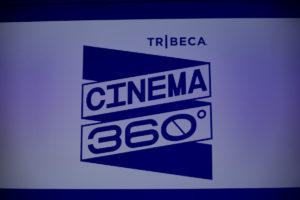
Ashe ’68 (Rex Miller)

Tennis champion Arthur Ashe (1943-1993) made history in 1968 when he triumphed at the U.S. Open, becoming the first African-American man to win it (still the only one, so far). Two years later he would also win the Australian Open and in 1975 he would win Wimbledon. Though mostly focused on the sport, he did not abstain from from activism, becoming a powerful champion of racial equality by virtue of his accomplishments. In Rex Miller’s Ashe ’68, which I saw as part of one of the festival’s Cinema360 screenings, we meet the man through archival footage, reenactments and animation, the whole put together in a successfully evocative mix that fully maximizes the possibilities of the 360º of the frame, especially through its rotating soundscape.
Bonfire (Eric Darnell)
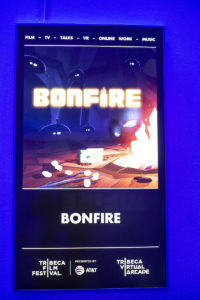
This was so much fun! Created by Baobab Studios, Bonfire places the viewer on an alien planet after a crash, accompanied only by a robot named Debbie. Baobab, according to CEO Maureen Fan, with whom I spoke at Tribeca, is committed to promoting stories that involve women and/or people of color, and cast Ali Wong as the voice of Debbie. She makes for an amiable sidekick, helping you to decide what to do when strange creatures emerge from the woods. Friends or foes, you decide, but how you decide and what you do has an effect on the experience. This is what VR can do well, placing you in a beautifully animated world and making you feel the complete immersion that the technology allows. The piece also raises ethical questions about the effects of colonialism and ethnic cleansing, sneaking in some important issues in the midst of the entertainment.
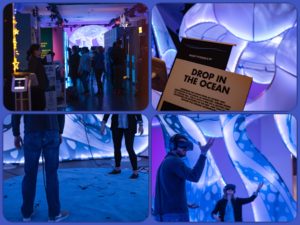
Drop in the Ocean (Adam May/Chris Campkin/Chris Parks)
Beyond the gorgeous physical installation that surrounded the viewing space, complete with spongey, convex floor to mimic the experience of standing on a jelly fish, Drop in the Ocean features a beautifully rendered animation of an undersea universe. We are inside the jelly, gazing out at sea turtles and whale sharks. Sadly, we also watch as trash sinks down from the surface, threatening all life below, and learn how climate change poses a serious risk to phytoplankton. If they go, we all go. Still, if this is how we learn about the future death of the planet, at least we have a delightful time doing it.
Gymnasia (Chris Lavis/Maciek Szczerbowski)

A splendidly unsettling ghost story set in an abandoned school gymnasium, Gymnasia starts off with distant sounds of giggling children and basketballs bouncing, on their own, around us. Then, off to the side, in the hallway, we see one of those old transparency projectors moving in fits and jerks, a small figure of a girl possibly on top. Shadows flash on the wall. Finally, a greenish boy appears on a stage, beckoning us to him as he sings, the space filling with eerie, orchestrated music. We quickly shift perspectives, finding ourselves up on the stage with the boy, who engages us with direct eye contact. The room in which it was installed contained a replica of the boy and girl (she still moving), adding to the experience. Creepy? You bet! And there’s the charm. I loved it, and actually wanted it to be much longer than its 6 minutes.

Into the Light (Jessica Brillhart/Igal Nassima)
The lone example of AR that I caught, Into the Light leads participants, each holding specially formatted smartphones, on a tour of a space where different locations are geotagged so that artwork by Sougwen Chung appears at those locations when one looks through the smartphone’s screen. Meanwhile, as an audio accompaniment, cellist Yo-Yo Ma plays Bach‘s “Unaccompanied Cello Suite No. 2 in D Minor,” comprised of 6 movements, each movement starting upon arrival at the new location (and activated by scanning a symbol on the wall). When one holds the phone in one way (up), it displays Chung’s art; when one holds it down, a black screen appears, with a white dot that indicates Ma’s position vis-à-vis the phone, and as one moves closer or further away, the volume changes, accordingly. If one moves into the center of Ma’s location, one also hears his heartbeat. This was my first time participating in such an experience. It was captivating, though I wish we had been able to hear the complete suite, rather than just snippets.
The Key (Céline Tricart) – winner of Tribeca’s Storyscapes Awards

This was one of two VR installations I saw which featured a live human actor as part of the experience, adding an element of immersive theater. The Key, produced for the “Oculus VR for Good” series, plunges into a child’s fantasy world, where dreams quickly turn into nightmares as beloved toys and possessions are stolen by monsters. When one first walks into the space, an actress in a simple white dress greets the visitor, activates infographics on a series of interactive screens, and then places the VR headset and headphones gently on one’s head. From there, we enter a young girl’s room, where actress Alia Shawkat guides us through our mission to safeguard her precious “companions” (three balls of light) from the arrival of evil creatures. Things go from bad to worse, but at the end, as we emerge from the VR back into the live space, the actress reveals, again through the interactive screens, that the entire experience has served as a metaphor for the trauma of our planet’s ever-worsening refugee crisis. It’s a moving, effective way to arrive at the tragic truth of the issue.
I spoke with director Céline Tricart afterwards, and asked her about her decision to include a live person in the installation. She said it was done partly to remove the violence of putting on headset, since she puts it on for us; she soothes our way into VR, and the transition from real to unreal and back again. I also asked her what kinds of instructions were given to the actresses (there were 3 in rotation between 2 identical spaces), since I had found it awkward and unsettling (in an interesting way) to navigate the proper way to interact her: was she a prop; should I acknowledge her presence and/or her humanity; was it OK to talk to her? Tricart said that each actress was asked to never speak, even if spoken to, and to read the viewer’s body language to determine how much to touch, if at all, while guiding them through the initial stages. I meant to go back and try it a second time, to see how much the experience might change with a different interaction, but never found the chance. That remains for someone else to attempt.
12 Seconds of Gunfire: The True Story of a School Shooting (Wesley Allsbrook/Seth Blanchard/Suzette Moyer)
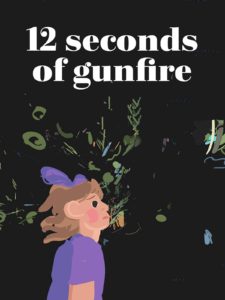
Another film I saw within the Cinema360 program, 12 Seconds of Gunfire: The True Story of a School Shooting tells the heartbreaking story of a shooting at Townville Elementary School in South Carolina, in which 7-year-old Jacob Hall was killed while friend Ava Olsen watched in horror. Rendered through colorful, evocative animation that drags our gaze around the virtual screen, the movie follows Ava’s narrative as she recounts what the loss of Jacob means to her. It’s not a happy experience, but beautifully made, using the technology to focus our attention on what matters. Like Ashe ’68, 12 Seconds of Gunfire also maximizes its possibilities through effective use of sound.
Where There’s Smoke (Lance Weiler)
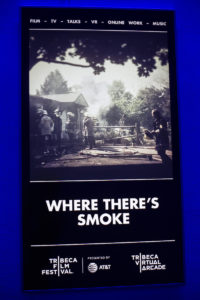
Filmmaker Lance Weiler has created a shrine of sorts to his late father’s obsession with fire, which I was lucky enough to see with him present as guide. Where There’s Smoke is a participatory documentary, where up to 4 participants (at least at the Tribeca installation) were led into an initial space and asked to revisit a space in which they have lived in the past (or present) and draw the one object that they would rescue if their home was on fire. Once that activity was done, we were asked to open Weiler’s father’s tool chest and extract certain items, including flashlights, before proceeding into an adjacent darkened room (decorated, including via odor, to be like a burned-out space) where, using a map, we located 4 objects and placed them in a (somewhat random, I will admit) order on light panels embedded in a center table. Each panel was weight-sensitive, and activated, in sequence, short archival films projected on a screen, telling different aspects of the father’s story and of the fires that played a big role in his and his family’s life. He was a fireman, but Weiler implies that he may also have been an arsonist.
Once the 4 films were done, we moved into the penultimate space, where we found the cards from the first room and discussed, amongst ourselves, why we chose those particular objects to save. Finally, on the way out, we again met Weiler in a space hung with his father’s photographs, discussing, with him, our takeaway of the exhibit. It was an overall fascinating experience, though we stumbled through some of the more interactive parts (part of the spell of the piece, I suppose). Weiler makes for a gentle docent, open to all views on what his work means. I particularly enjoyed the exercise of choosing which object I would rescue and exploring the reasons why, making of Where There’s Smoke a personal journey as much for me as for Weiler.
Wolves in the Walls: It’s All Over (Pete Billington, Jessica Yaffa Shamash)

How wonderful it is to randomly select a movie, just because it is the first one you walk by, at the start of press hours when there is no line and discover that you have chosen a good one. Adapted from a short story by Neil Gaiman, Wolves in the Walls: It’s All Over places us in the nightmare that is young Lucy’s world, where scratchings and scampering from within the walls of her house indicate a sinister presence about to strike? Are they demons? Wolves? Demon-wolves? We move from space to space, following instructions from Lucy to pick up a magnifying class for a closer look, to hold a glass up to the wall for a closer listen, to crank a jar maker in the kitchen to create food for the wolves to eat (to hold them at bay), and more.
Suddenly, in a flash, after a misfired attempt to help, we find ourselves inside a video game inside the VR experience, slashing at 1980s-era digital facsimiles of lupine invaders with a sword. Fun! One of my favorite moments came when my hand brushed against an artfully placed furry coat inside the real-life space in which my body thrashed about, giving me the impression of touching a wolf, myself. When I asked Wolves in the Walls’ choreographer Elizabeth Carena, who guided me into the installation, about this, she admitted that, yes, this was an intentional bit of set design.
Along with Gymnasia and The Key, this was one of my top three of this year’s Tribeca VR films. Given what a great time I had here, next year, I will try even more! So,that’s it for Part 1 of my Tribeca 2019 coverage. Up next: Part 2, on the traditional films …


